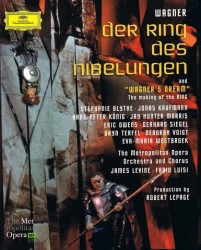 Wagner – Der Ring Des Nibelungen; Wagner's Dream, a documentary
Wagner – Der Ring Des Nibelungen; Wagner's Dream, a documentary
Robert Lepage; Metropolitan Opera
Deutsche Grammophon 073 4770 (8 DVD) 073 4771 (5 Blu-ray)
This set is derived from the Live from the Met broadcasts from the 2010/11/12 seasons and is the second Ring cycle from the Met for the home screen. The first was the Otto Schenk/Gunther Schneider-Siemssen cycle that was seen on PBS in the early 1990s. While watching these new discs I thought about this earlier set and had a peek. The peek turned into a marathon. Every aspect of that cycle pleases me; the mise-en-scène, the cast and Levine’s direction. It remains the perfect document exemplifying the traditional productions of the last 100 years (DG 073043-9, 7 DVDs).
Dutifully returning to the Lepage Ring, as it is now referred to, was an utterly different experience, drawing undue attention to and distracted by the stage-wide row of planks waving around and wondering what they will do next. Viewing these four music dramas in the theatre over three years, many were disappointed, perplexed and intolerant of such a radical departure from tradition.
Wagner’s Dream is an engrossing, informative documentary of the philosophy, concept and construction of “The Machine,” the brainchild of Robert Lepage. We are in on its fabrication in Quebec and the installation at the Met. Then the inevitable little hitches as stage people, the choreographer and the singers familiarize themselves with this 9,000 pound machine and its ability to produce the desired result. The Machine, it dawned on me, is simply an elaborate new form of scrim, adjustable in countless ways to also provide planes according to the needs of the scenes, while the projected images serve only to evoke the surroundings and not to furnish them. Once the penny dropped, it all seemed so obvious. I no longer lamented the absence of traditional three-dimensional sets but was well aware of the atmosphere and environment.
This was to be Levine’s Ring but due to his declining health he was able to conduct only Das Rheingold (October 9, 2010) and Die Walkure (May 14, 2011). The cycle was completed by Fabio Luisi who had assumed the post of principal conductor of the Metropolitan Opera on September 6, 2011: Siegfried (November 5, 2011) and finally Götterdämmerung (February 11, 2012).
Singers in the principal roles remain constant across the four dramas including Bryn Terfel as Wotan, Stephanie Blythe as Fricka, Hans-Peter König as Fafner and Hunding and Hagen while Gerhard Siegel is Mime and Eric Owens is Alberich. This is Deborah Voigt’s first Brunnhilde and Jay Hunter Morris’ first Met Siegfried but the viewer would never guess it, so “to the manner born” are their performances. I see and hear them as ideally cast. Morris was born and raised in Paris, Texas and in conversation has not lost his charming Texas drawl. The many interviews with each tell their stories.
Jonas Kaufmann appears only in Die Walkure where the attraction of his Siegmund to Eva-Maria Westbrook’s Sieglinde is exquisitely intense. Performances from Voigt, Morris, Terfel and König are outstanding but there are no lesser players. Conversations and interviews with the principals caught between acts in the original transmissions are included as separately tracked extras.
The Met orchestra has been honed to perfection over the years and their enthusiasm and sensitivity can be movingly gentle or strongly dramatic with enormous horsepower where called for.
This unique set will be irresistible for many Ring fans, and diehard traditionalists may be pleasantly surprised.



